Following my visit to Menton, I went to the train station and practically started to return in the direction of Nice, by moving two train stations farther, to the place called Roquebrune-Cap-Martin.
The town itself is situated quite uphill in relation to the train station and let me say right away that I had no intention of climbing up there. Suffice to see and take a photo from the platform of the train station of the medieval castle in Roquebrune and the tower of the Church of St. Margaret.
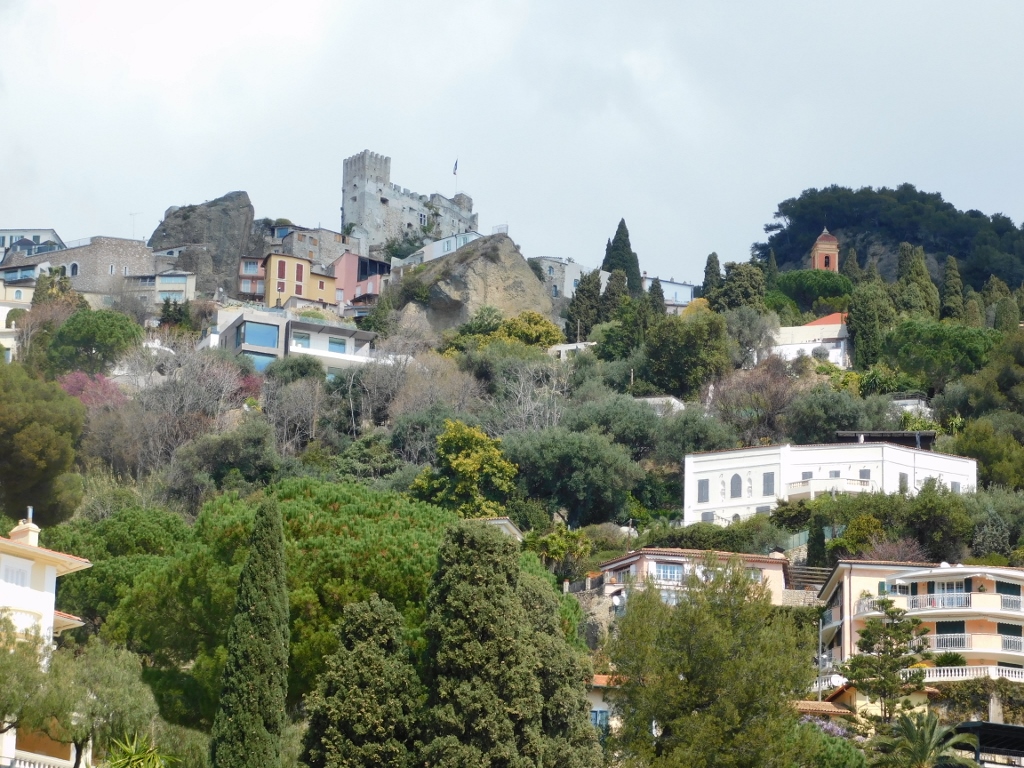 Roquebrune-Cap-Martin
Roquebrune-Cap-Martin
As there is another place in France of the same name (Roquebrune), the one on the coast of the Mediterranean Sea has the Cap-Martin added, after the neighbouring peninsula which is a rather exclusive place for living that in addition to wealthy estates also includes a number of exotic gardens and a larger park.
In the background of the town, one can see the slopes of mountain Mont Gros on the top of which there is a runway for paragliders. If you look at the following photo a little more closely, you can see as many as three paragliders.
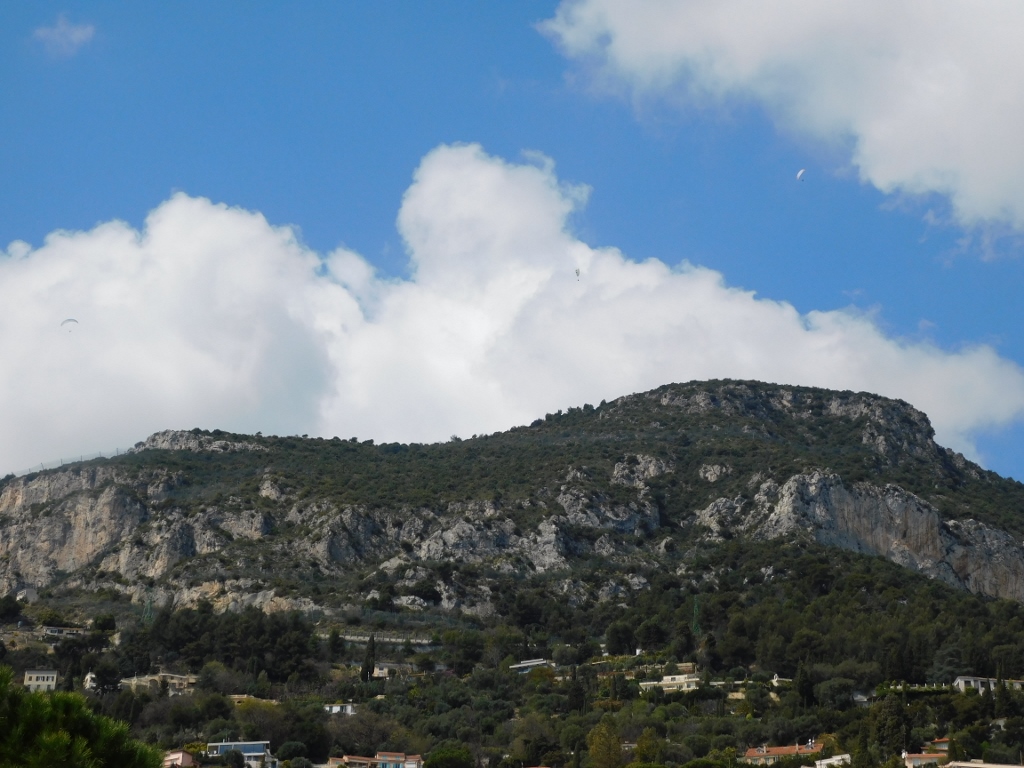 Mont Gros and paragliders
Mont Gros and paragliders
A little later I took a photo of only one paraglider against the backdrop of an expensive hotel built on the top of a cliff.
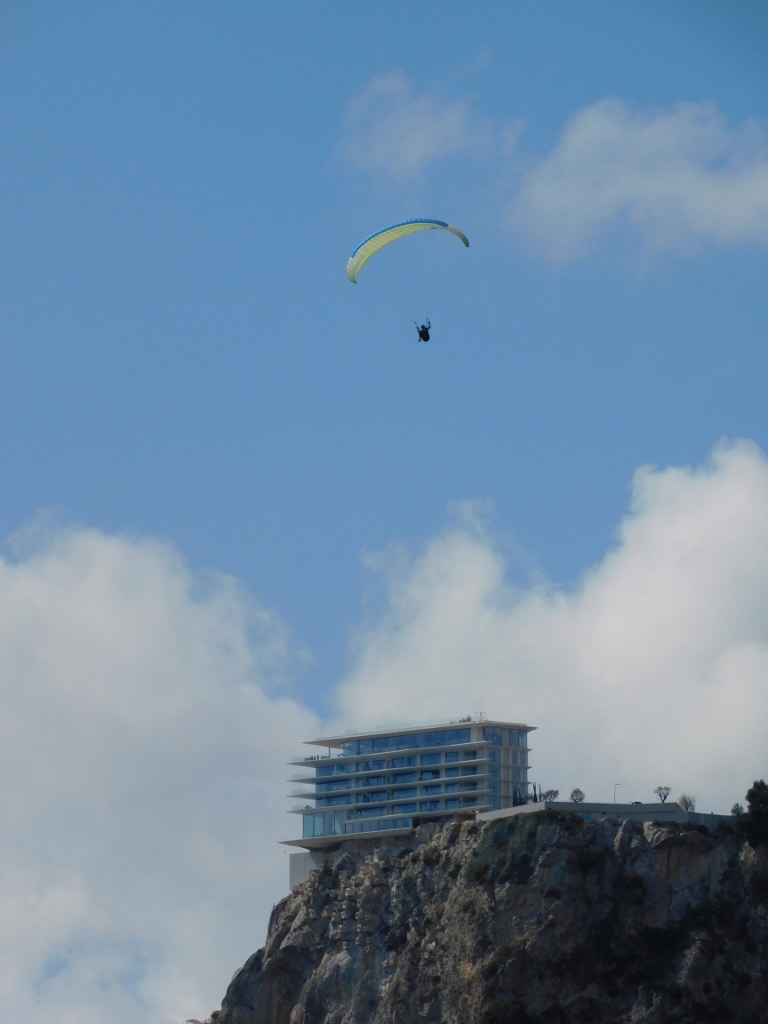 A paraglider and a hotel
A paraglider and a hotel
So, as I was obviously not interested in anything to do with heights here, I started to go down to the closest beach and that was the Buse Beach (Plage du Buse).
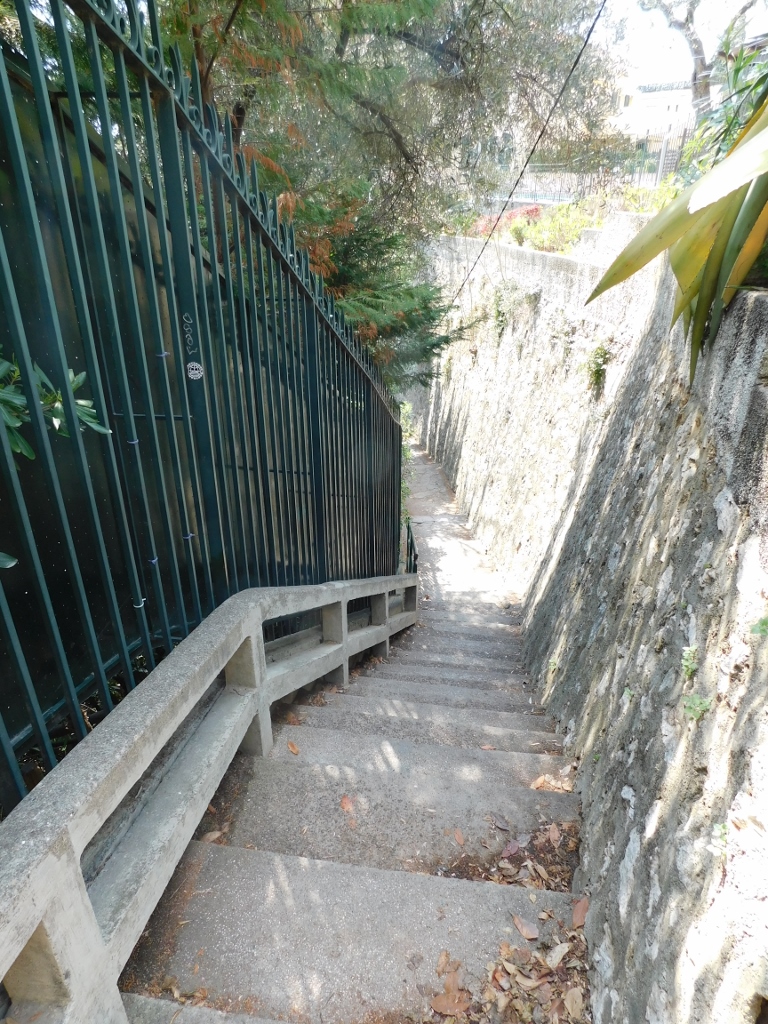 Steps leading to the Buse Beach
Steps leading to the Buse Beach
The path I followed brought me to the west end of the beach that was completely covered by dried algae and stepping over such a base was very interesting – as if walking over a very thick carpet. I guess it was still far too early for the swimming season and thus nobody bothered to clean up the beach a little. On the other hand, there were a couple of people who sunbathed in the part of the beach without the dry algae.
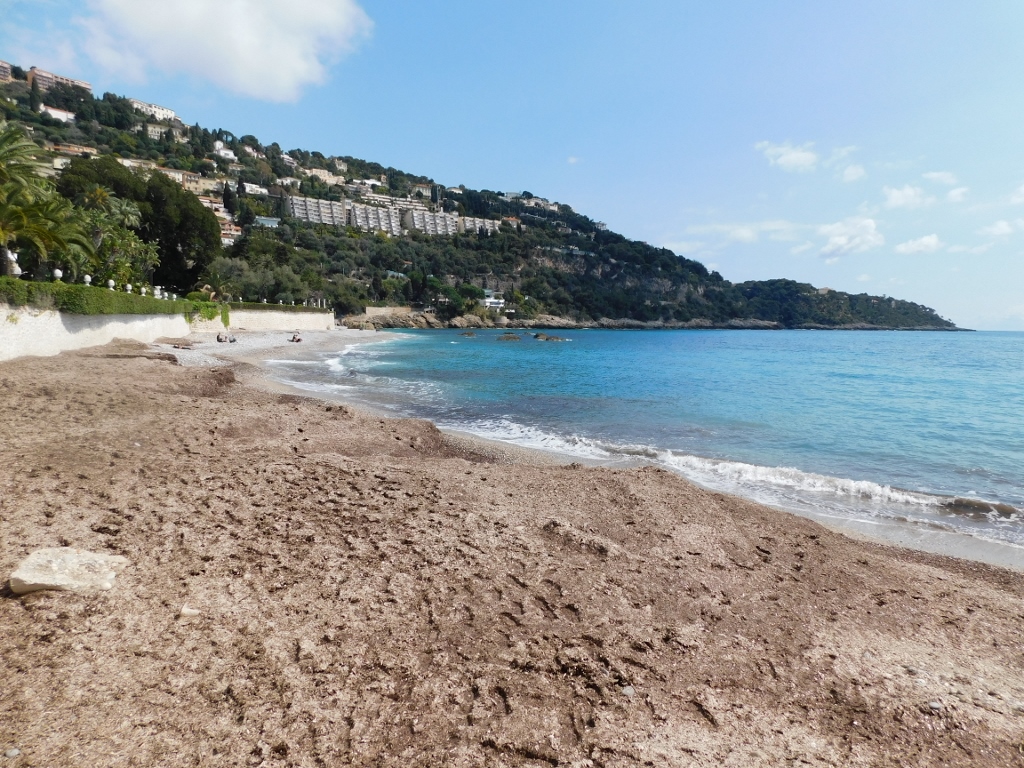 Plage du Buse
Plage du Buse
I neither sunbathed nor swam, coming here only in order to go for a short walk. Near the other, east end of the beach passes one of the numerous littoral walking paths that can be found on the Riviera. Still, before I dealt with the walking path, I looked back and that rewarded me with a beautiful view. Namely, already the next train station after Roquebrune-Cap-Martin in the direction of Nice is Monaco-Monte Carlo and parts of this principality can be seen from this beach as well.
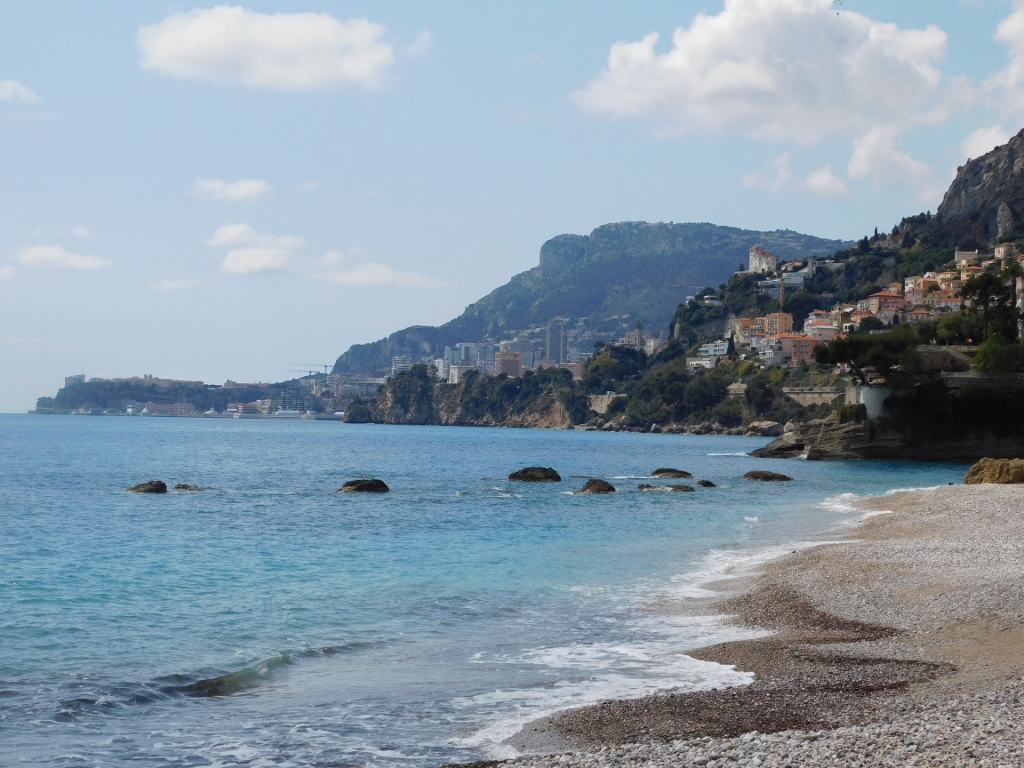 Buse Beach, parts of Roquebrune-Cap-Martin and Monaco in the distance
Buse Beach, parts of Roquebrune-Cap-Martin and Monaco in the distance
Then I climbed up to the walking path and such paths are abundant in the littoral. In this particular section of the French Riviera one can walk from Menton to Monaco and that path is some 15 km long. I do love to walk, but on this day I did not have a lot of time because of the exceptionally ambitious sightseeing plan, so I decided to walk along the path just a little and that was to an interesting site.
 French Riviera in Roquebrune-Cap-Martin, with the coastal path on the right-hand side
French Riviera in Roquebrune-Cap-Martin, with the coastal path on the right-hand side
In some sections the path is paved and fenced-off, while in some other sections it is more on a “wild” side. Some sections render nice views and in some other sections the path is surrounded by tall vegetation.
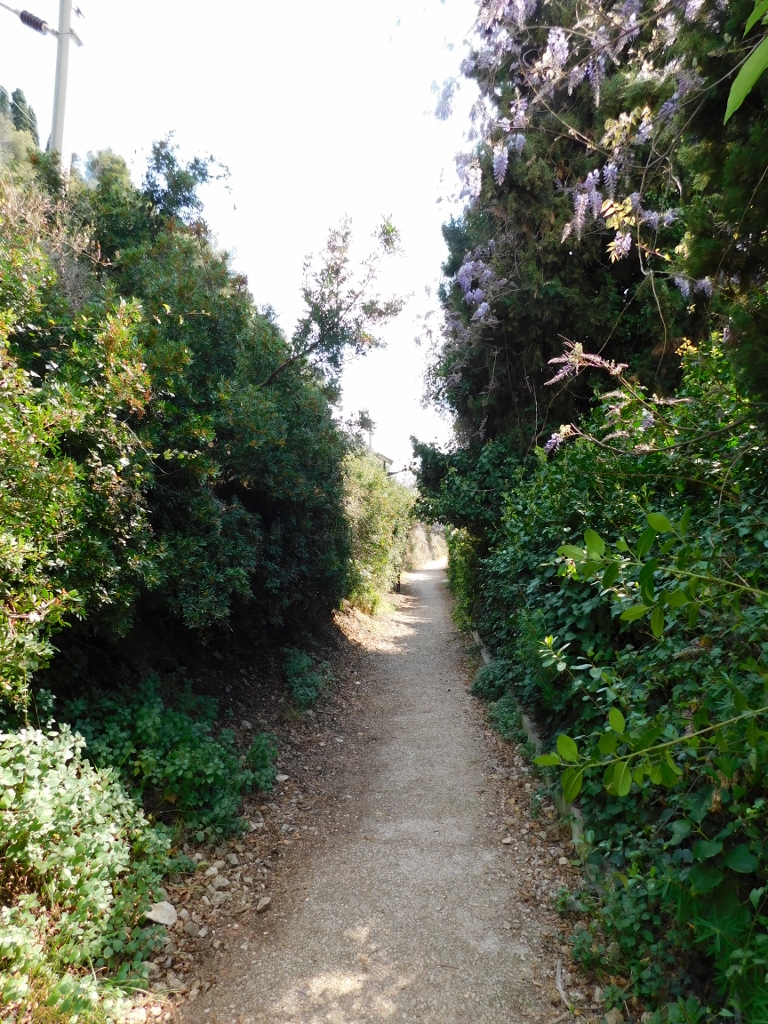 A part of the coastal path in Roquebrune-Cap-Martin
A part of the coastal path in Roquebrune-Cap-Martin
I did not go very far along the path, just a few hundred metres, but I certainly enjoyed even this short walk. Regardless of the duration, I could often have a nice westbound view where one can see parts of Roquebrune-Cap-Martin, as well as parts of Monaco.
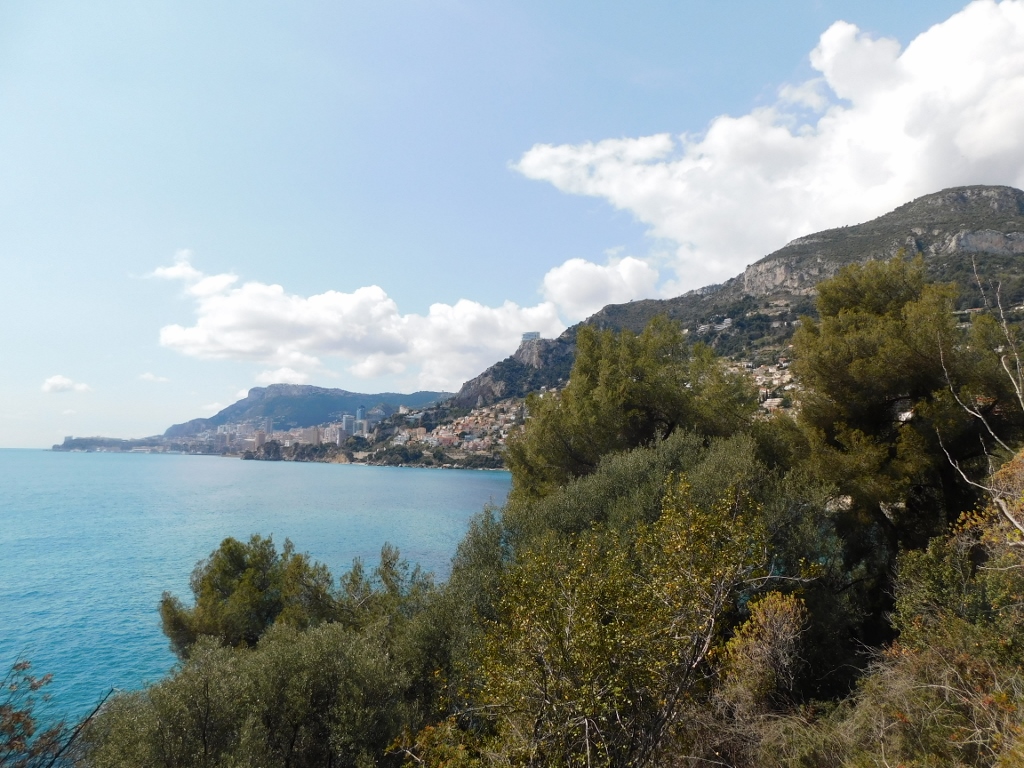 View from the coastal path in Roquebrune-Cap-Martin
View from the coastal path in Roquebrune-Cap-Martin
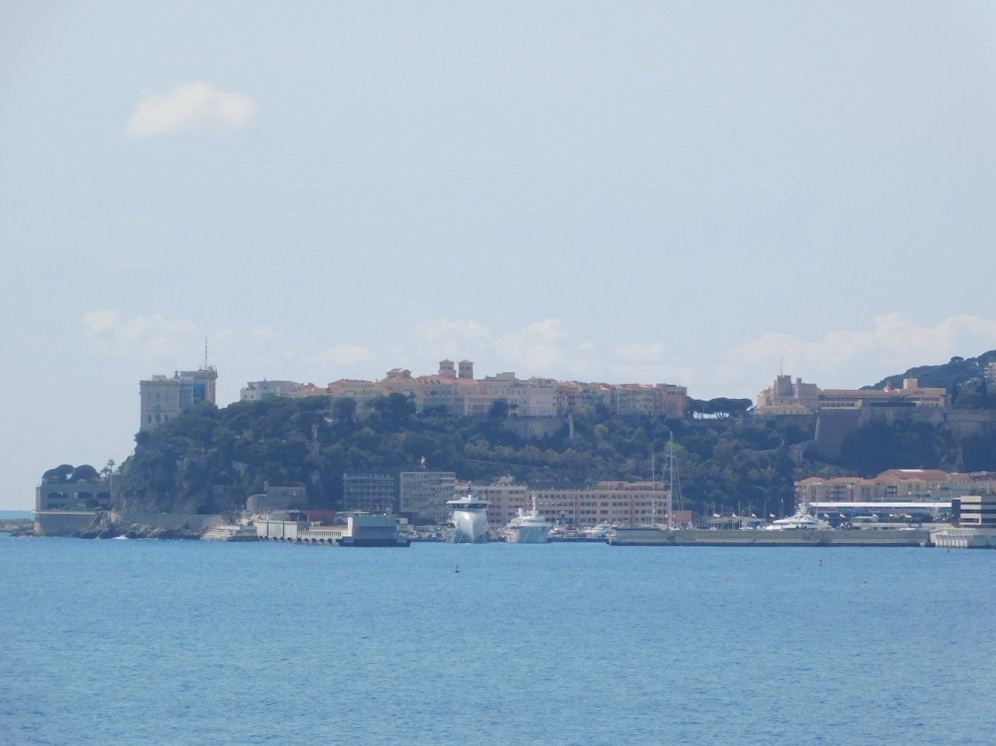 Monaco: the Oceanographic Museum, old part of Monaco and the Residence of the Prince of Monaco
Monaco: the Oceanographic Museum, old part of Monaco and the Residence of the Prince of Monaco
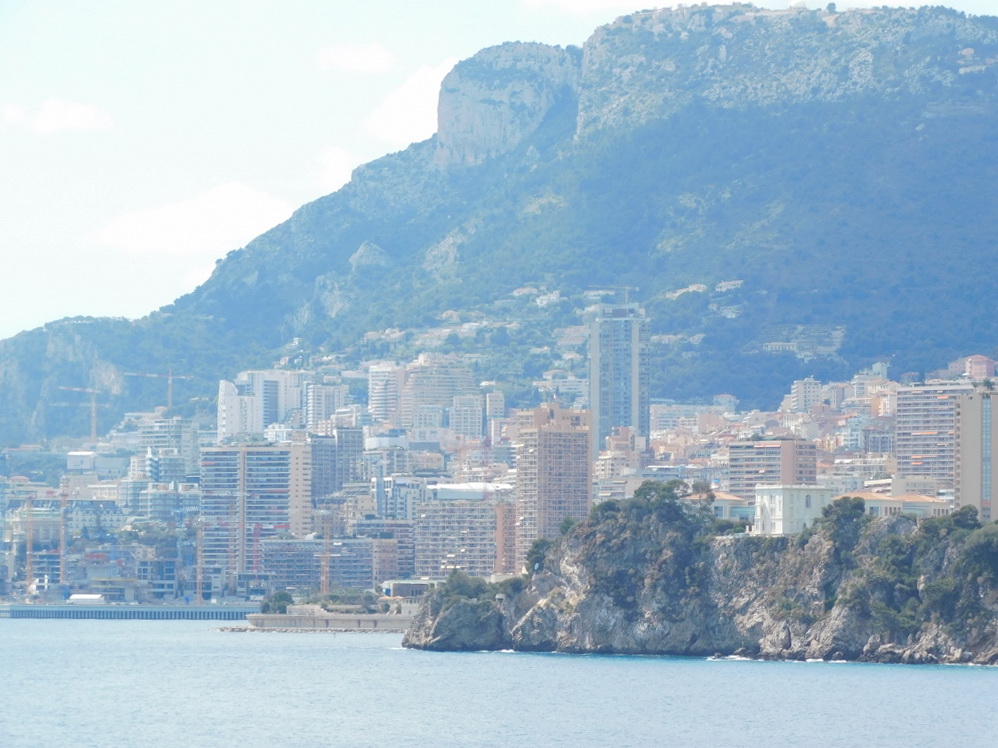 Monaco: modern parts of Monaco
Monaco: modern parts of Monaco
What is also interesting with regards to this trail is that it passes by a property in which there is Le Corbusier’s Shed (Le Cabanon); practically his vacation home. This is the only place which the famous architect designed just for himself. It is a minimalistic shed made of wood logs built in 1951 and Le Corbusier used to come here every year for a month for his holidays. He also passed away here in 1965 from heart attack while swimming in the sea. He is buried at the cemetery in Roquebrune-Cap-Martin. In order to visit his shed, it is necessary to book the time slot in advance and then the visitor may go for a guided tour. Needless to say, I had no idea when I would get here, so I did not book anything and could only take a photo over the fence of the steps that go down the property. Let me just mention that the green shed seen in the following photo is not that of Le Corbusier.
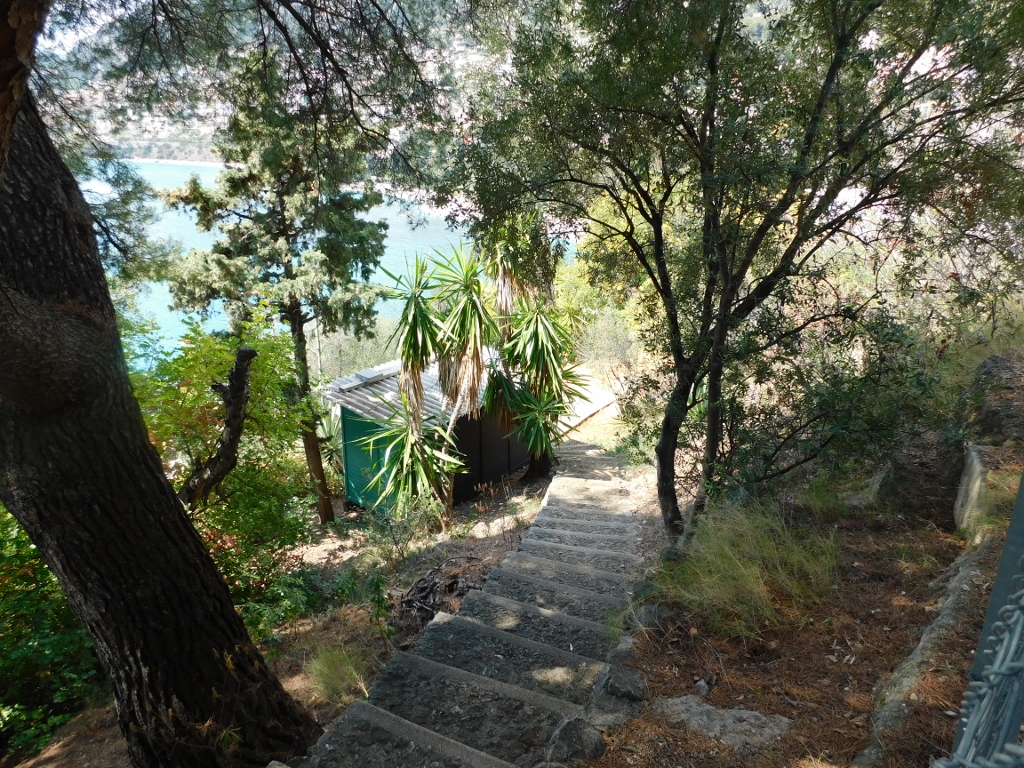 Property where Le Corbusier’s Shed, Le Cabanon, is
Property where Le Corbusier’s Shed, Le Cabanon, is
As it was the beginning of April, some plants by the trail were in full bloom, like numerous wisterias (Wisteria sinensis).
 Wisteria in April
Wisteria in April
Relatively soon I started to return along the trail in the direction of the railway station. I did not go down to the beach this time, but again I had a lovely view from time to time.
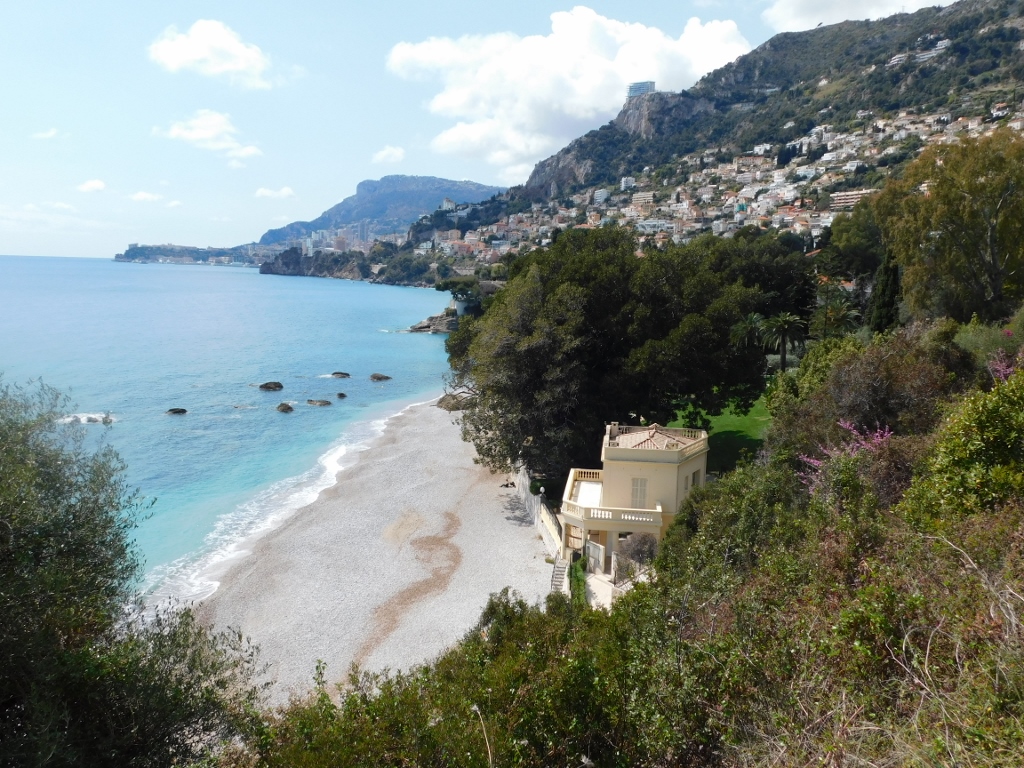 Buse Beach, parts of Roquebrune-Cap-Martin and Monaco in the distance
Buse Beach, parts of Roquebrune-Cap-Martin and Monaco in the distance
Soon I reached the train station and while waiting for the next train, I admired somebody’s tropical garden that is situated right above the railway line.
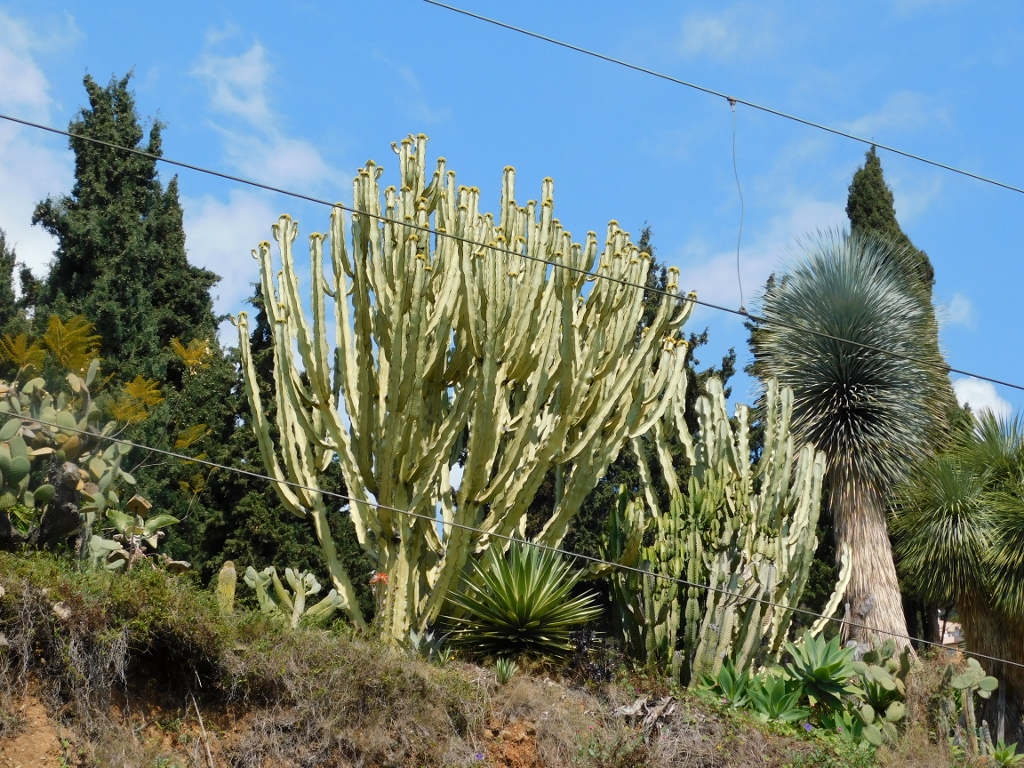 A detail from the surroundings of the train station in Roquebrune-Cap-Martin
A detail from the surroundings of the train station in Roquebrune-Cap-Martin
On this day, my plan was to visit two more places on my way back to Nice – Monaco and Beaulieu-sur-Mer. It was early afternoon and I thought it would be better to go to Beaulieu first, which at that point was slightly farther away (from my current position Monaco-Monte Carlo was the first train station, while Beaulieu was the fourth one), and then to return to Monaco. I was not sure if my train ticket covered this kind of to and fro along the French Riviera, but I hoped there would be no problems in case of a ticket control.
There were several reasons for such a decision of mine. I had fewer places to visit in Beaulieu and many more in Monaco. The sun was setting around 8 in the evening, so I thought it would be better to see what I wanted in Beaulieu during the day, since I would need less time, and afterwards to see most of the things in Monaco while there was still sunlight and then possibly, if I could sustain that long, to see something in the evening. And finally, I was starting to get hungry and so I thought it would be easier for me to find a restaurant in a smaller place, meaning that I would spend less time searching for it in smallish Beaulieu than in larger Monaco. So I did all of this, but in the end I was not sure at all that my plan was good. The main reason was that the trains were late from time to time (they were supposed to run every 30 minutes during the day) and this took away considerable time.
Be as it may, I waited for the train and a little later I transferred to Beaulieu-sur-Mer.
One of my favourite comedies of all time is “Dirty Rotten Scoundrels.” I think I must have seen this film at least 20 times and every time I would double with laughter. One of the main “roles” is played precisely by Beaulieu-sur-Mer which is called Beaumont-sur-Mer in the film and this is the name of the town in which most of the action takes places. The film was shot on the French Riviera in 1988 and whoever wants to see what the most elegant and most expensive places in this part of France look like may have a look at the film. Perhaps others might enjoy it and laugh as much as I have.
In any case, once in Beaulieu I headed from the train station in the direction of the coast, looking around if there was a restaurant I could sit down for a lunch. Everything seemed sleepy somehow.
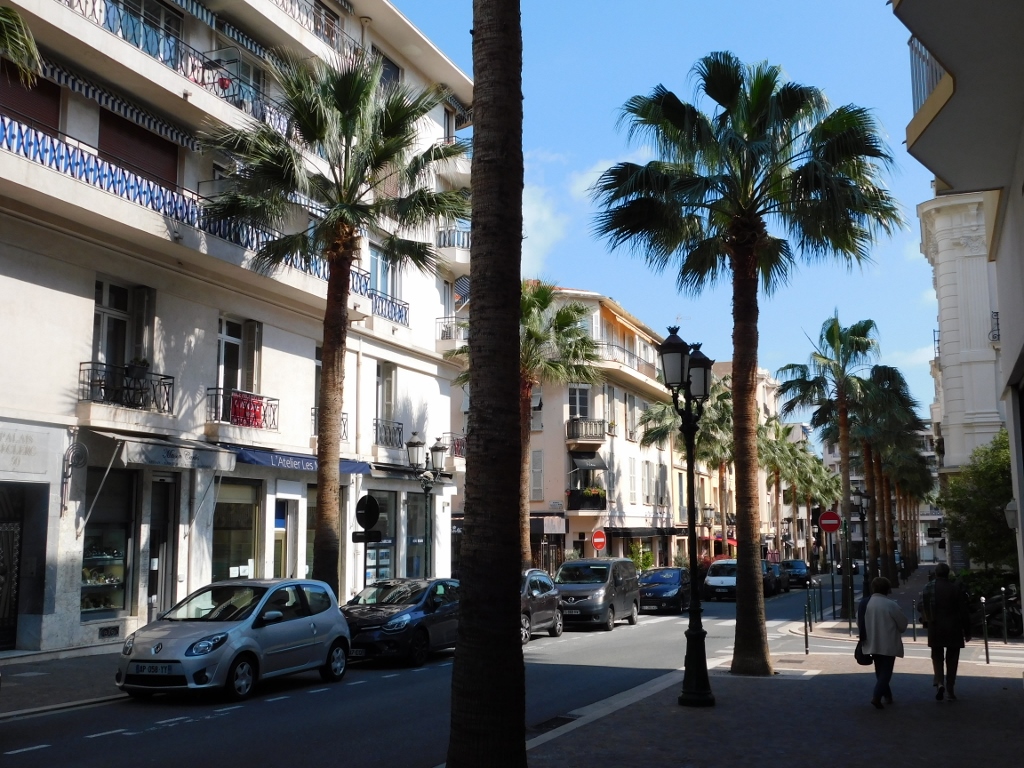 Beaulieu-sur-Mer
Beaulieu-sur-Mer
Although I noticed a couple of restaurants in the main street leading to the coast, they all seemed too empty or even closed, plus I did not feel like sitting down in an “ordinary” street. Namely, I imagined myself sitting somewhere where I would be able to look at the sea or have a nice view of some other kind. Here, however, I found it interesting when I came across a shop with Russian goods. This was all happening in April 2022 and various sanctions of the Western world to Russia were already in full force, but this was not just any goods. Among other things, this shop was selling – caviar. And when it comes to the enjoyment of wealthy people (for it was quite clear that this was a very expensive shop), then the boundaries and sanctions obviously do not exist.
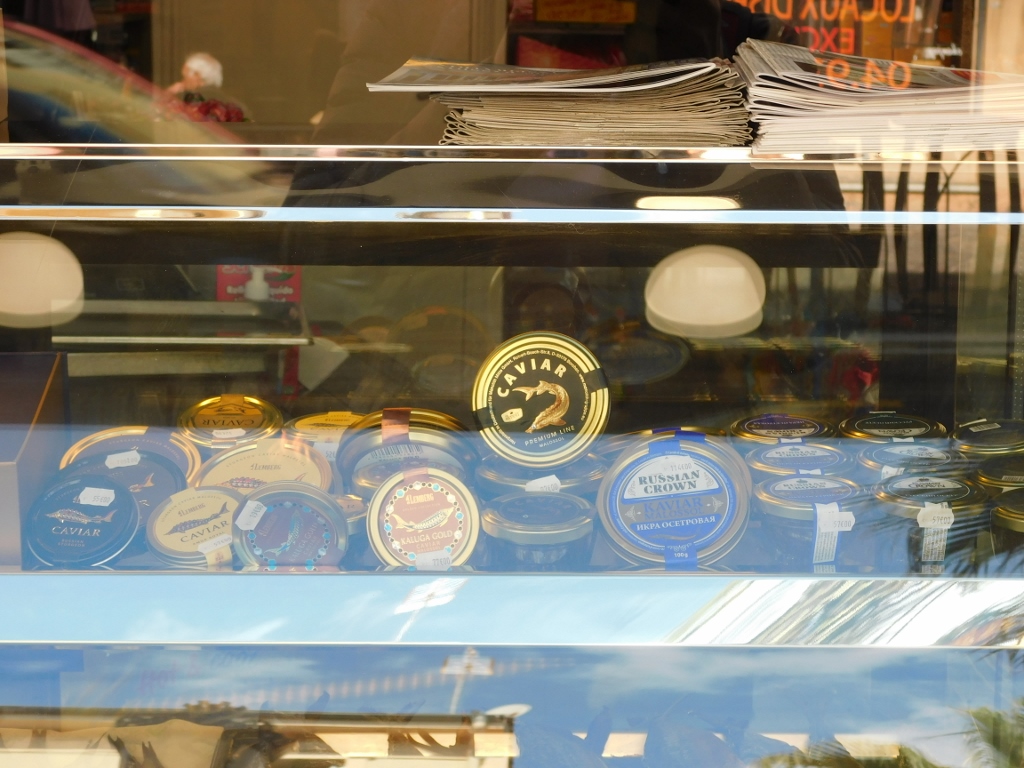 Russian caviar in the time of sanctions
Russian caviar in the time of sanctions
Looking at the map of the town on my mobile phone, I headed for the port and thus I walked past the Church of Sacré-Cœur of Beaulieu (Eglise du Sacré-Coeur de Beaulieu), meaning – the Church of Sacred Heart.
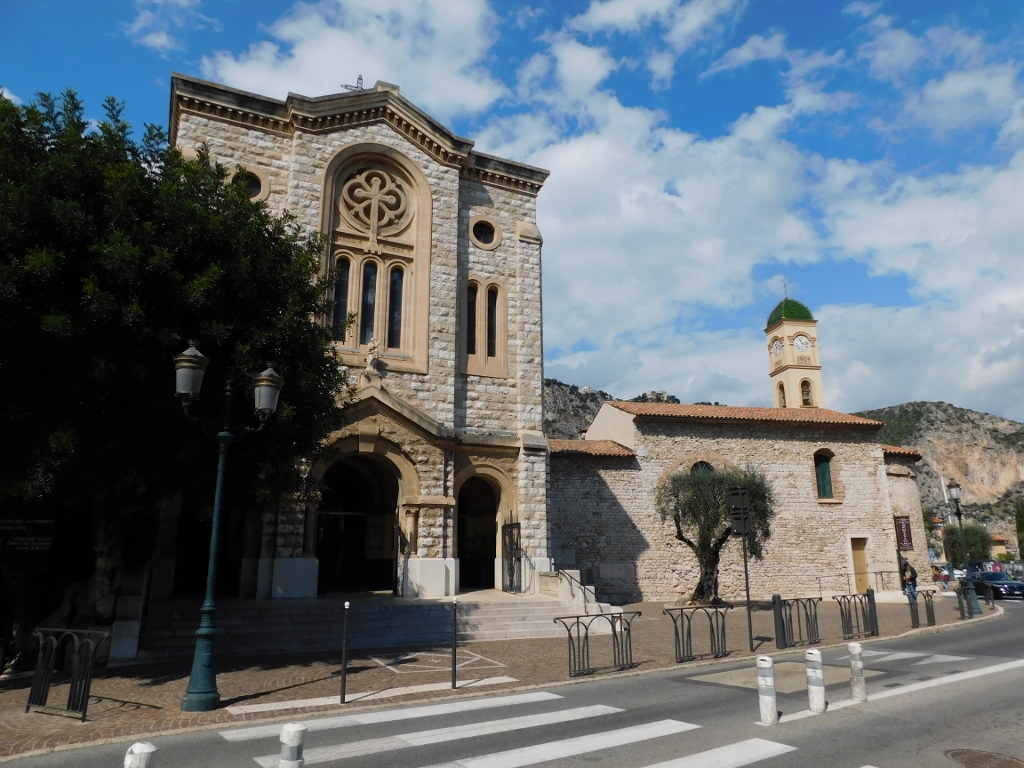 Church of Sacré-Cœur of Beaulieu
Church of Sacré-Cœur of Beaulieu
Soon I reached the port where I noticed a couple of restaurants and so I went to one of them. It was already after 3 in the afternoon and I was hungry.
 Port in the town of Beaulieu-sur-Mer
Port in the town of Beaulieu-sur-Mer
And then the reality reminded me “harshly” of a local custom – the restaurant kitchens are often closed after lunch (usually already around 2.30 pm) and here I could only get cakes. That did not seem right for my empty stomach, so I just got out and continued to walk along the coast before going back to the train station.
I went to the opposite side in relation to the main street and thus I got to Fourmis Bay (Baie des Fourmis). From here I could see the peninsula of Saint-Jean-Cap-Ferrat which, according to some estimates, is the second most expensive residential location in the world after Monaco. I did plan to go to that peninsula and visit a villa there, but I realised that this would be too much on this occasion, primarily in terms of the time, so I simply turned around and headed for the train station.
 Fourmis Bay, while Saint-Jean-Cap-Ferrat is on the right-hand side
Fourmis Bay, while Saint-Jean-Cap-Ferrat is on the right-hand side
In the photo above, on the left-hand side, one can notice a very interesting building. This is Villa Kerylos that can be seen even better in the following photo.
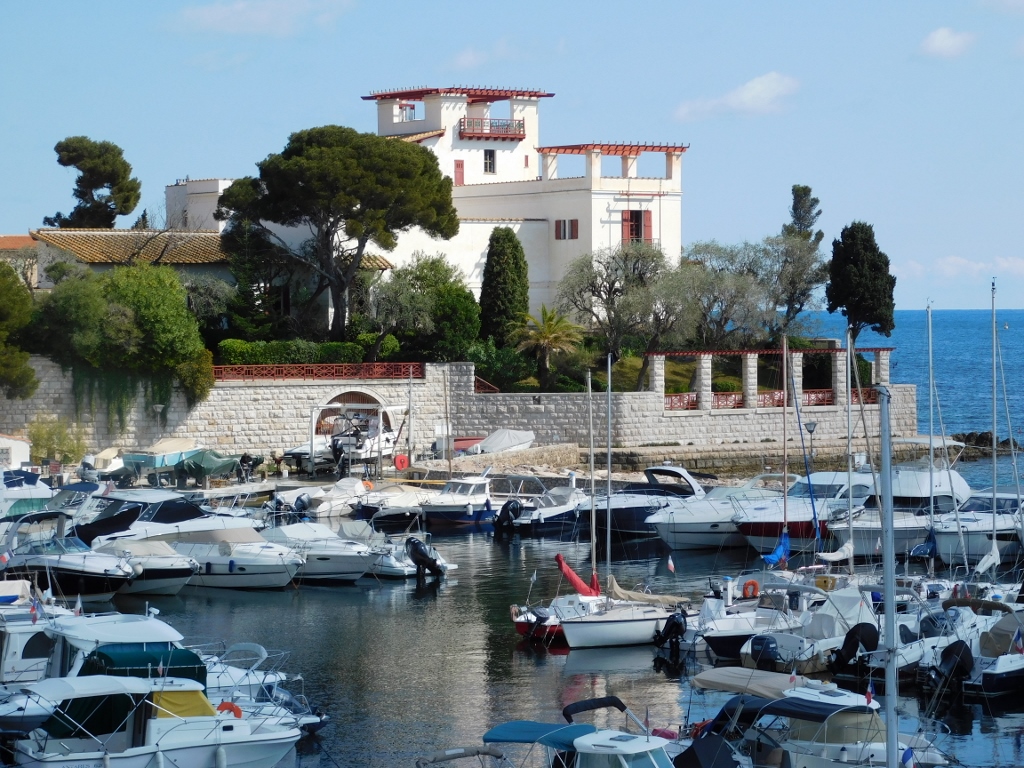 Villa Kerylos
Villa Kerylos
This villa was built at the beginning of the 20th century by archaeologist Theodore Reinach and his wife who came from a very rich family. The villa was made in an ancient Greek style and it was named after the Greek word for kingfisher that represented a good omen in the Greek mythology. Villa Kerylos was envisaged as an imitation of a palace from the island of Delos, Greece, from the 2nd century BCE. In the interior, one can see copies of mosaics and frescoes linked to ancient Greece, and there is also visible influence of ancient Rome and Egypt. The furniture was also made after the paragons from the antiquity.
During WWII, the Nazis took over the villa, while its owner, the eldest son of Theodore Reinach, together with his wife and two children were sent to Auschwitz concentration camp in 1943 where they were then killed. Nowadays, the villa, a French historical monument, houses a museum that is open to public.
But, I did not go to this museum either, since a week on the French Riviera is not enough for detailed visits, only for superficial sightseeing and walk. And I found this to be quite sufficient.
On the opposite side of the street in relation to the point from which I took the photos of the bay and the villa, there is a magnificent building, La Rotonde, that was built at the beginning of the 20th century as an addition to the Hotel Bristol in order for the wealthy British clientele to be able to enjoy their 5 o’clock tea. Nowadays, it has been turned into a restaurant.
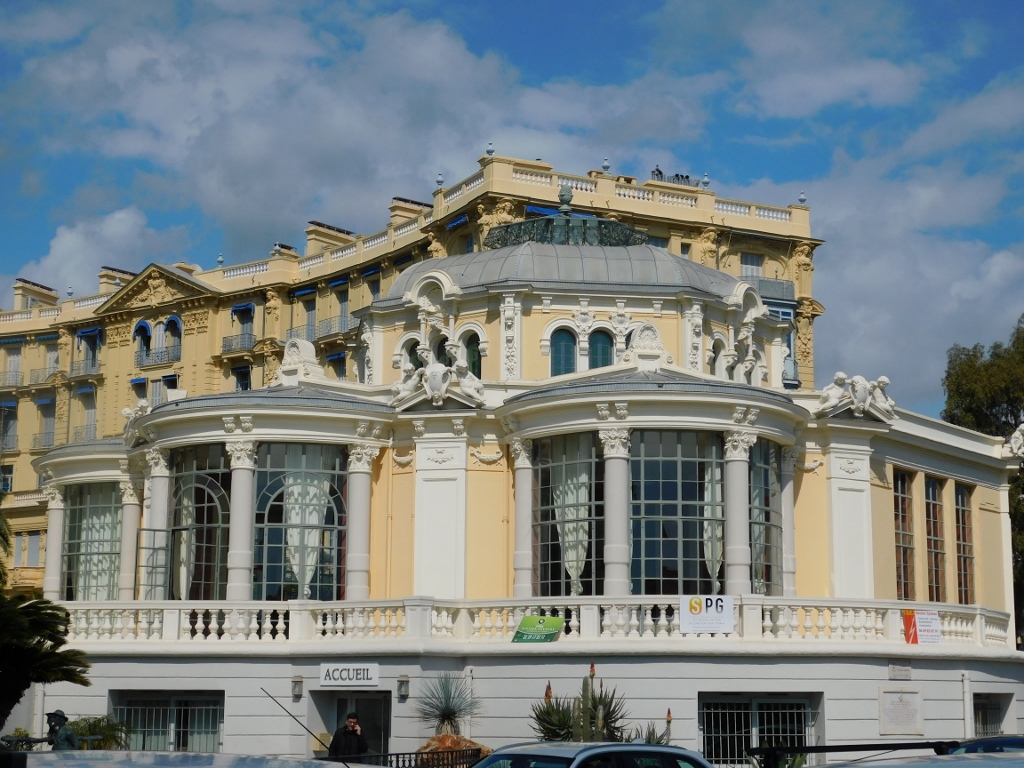 La Rotonde
La Rotonde
Needless to say, I did not even try to get in for lunch, but rather hurried back to the train station. Since I had enough time until the next train to Monaco and was hungry, I went to a nearby supermarket and bought a bag of crisps and a bottle of juice. Extraordinary circumstances require extraordinary measures. The “lunch” was far from impressive, but by the time I finished with it, I was already in Monaco and was no longer hungry.
The train station in Monaco-Monte Carlo is dug into a mountain like a huge underground station and it is one of those contemporary structures with a lot of artificial lighting, numerous stairs, elevators and hallways. There are several levels at the station and it is necessary to be careful about where one exactly wants to go, since there are several entrances/exits.
I was not quite sure, but using some signs and the orientation provided by my mobile phone, with some wandering, I got out at one of the side exits, but this turned out to be the right place which also provided me with an excellent view at the port.
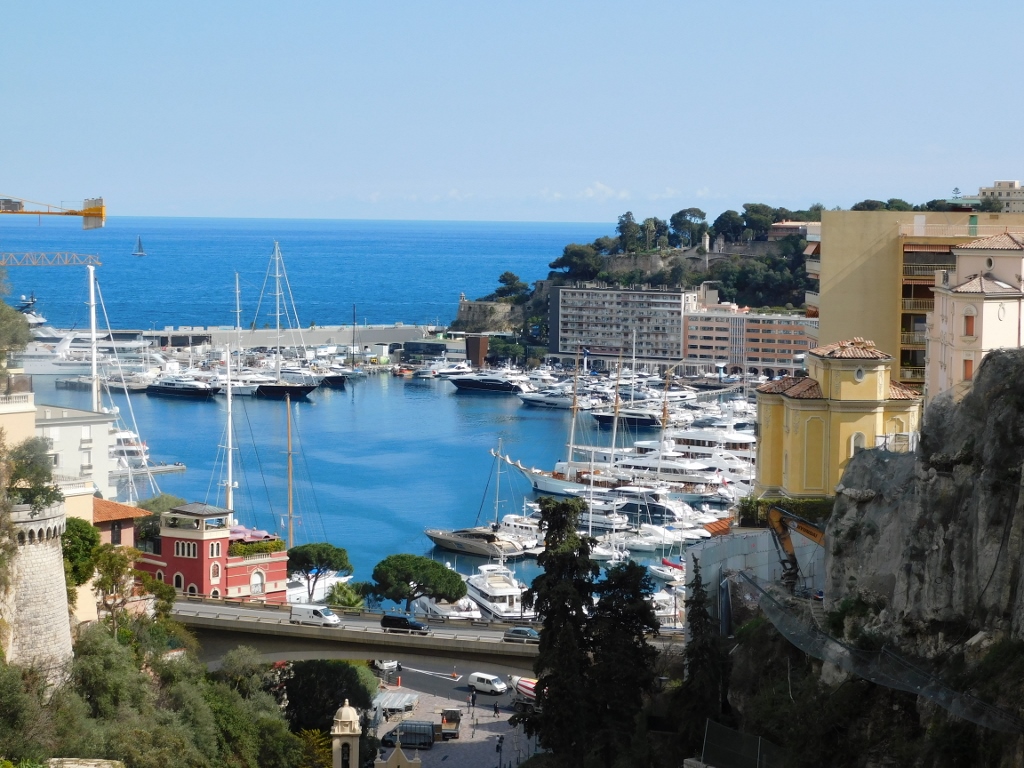 Port in Monaco
Port in Monaco
Soon I reached a street and started to go down towards the lower sections of Monaco. The Principality of Monaco covers an area of a little over 2 square kilometres and Vatican is the only country the surface area of which is smaller than that of Monaco. But, even within such small area, there are lots of steep sections and many individuals keen on living in Monaco, which in turn means that high-rise buildings are constructed at every available piece of land.
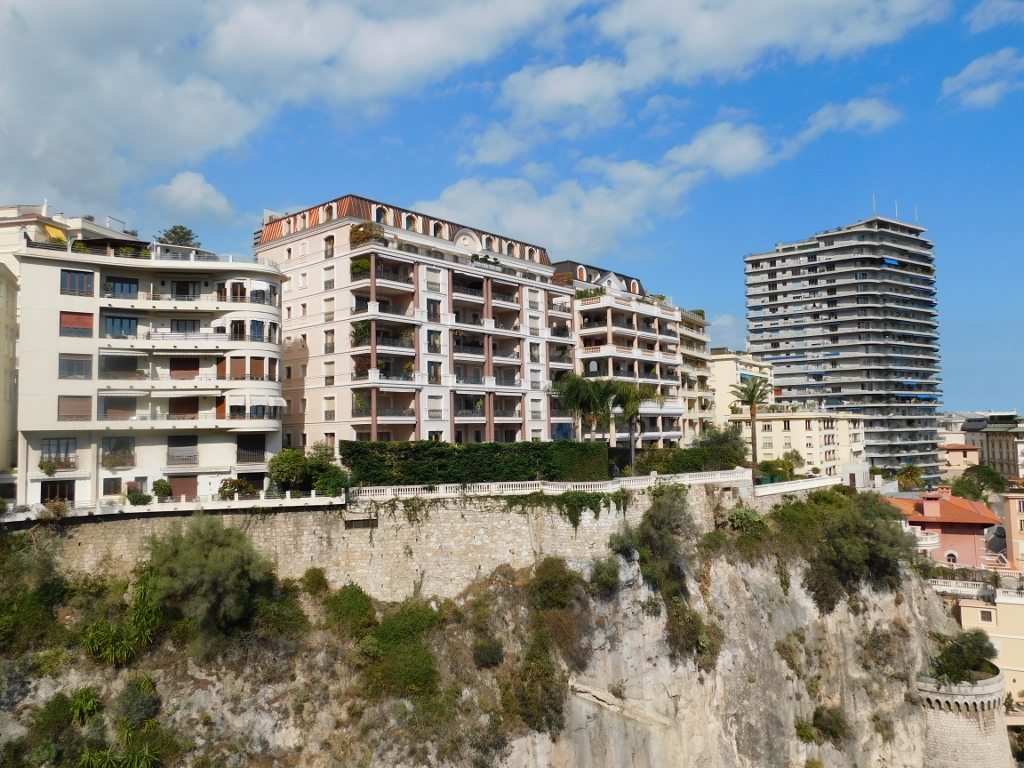 Monaco, a detail
Monaco, a detail
As I walked down between densely constructed residential buildings, from one spot I could see nicely a hillock that I planned to climb to after descending from the one I was currently on. This other hill is the part called Monaco City (Monaco-Ville), although formally speaking this is not a city, but rather a historic and administrative area. Informally, that section of Monaco is called “The Rock” (Le Rocher).
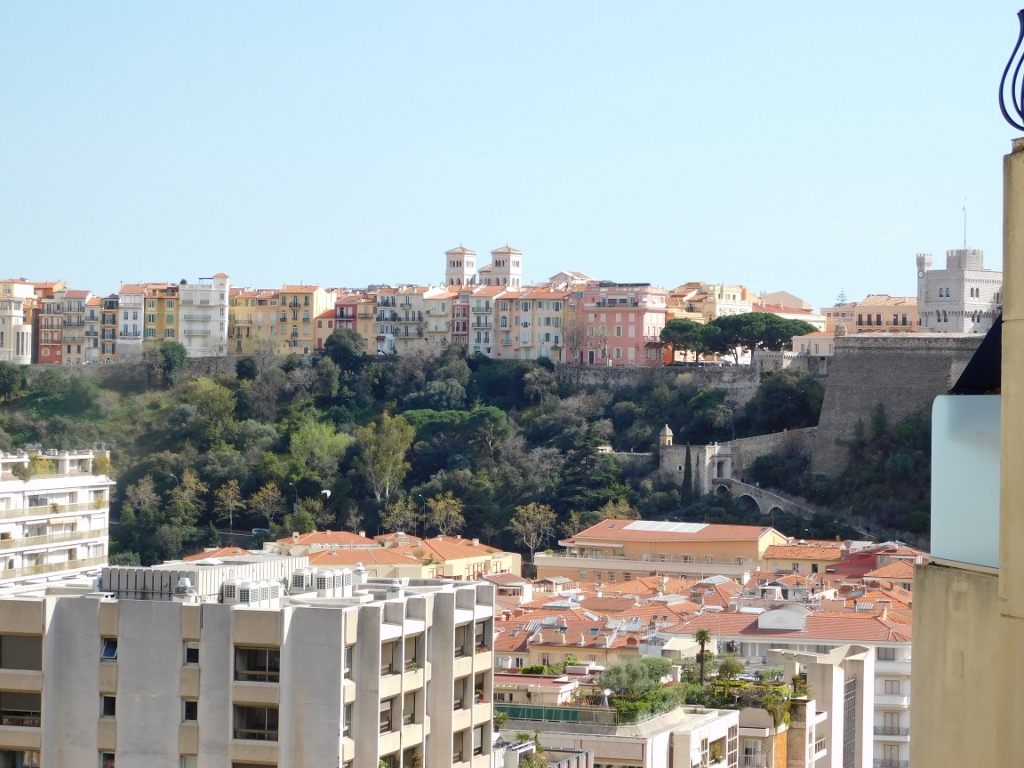 Monaco City on the other hill: you can see the towers of the Cathedral and all the way on the left a part of the Prince’s Palace
Monaco City on the other hill: you can see the towers of the Cathedral and all the way on the left a part of the Prince’s Palace
Meanwhile I passed between dizzily tall buildings, with numerous support structures that help augment the available construction area.
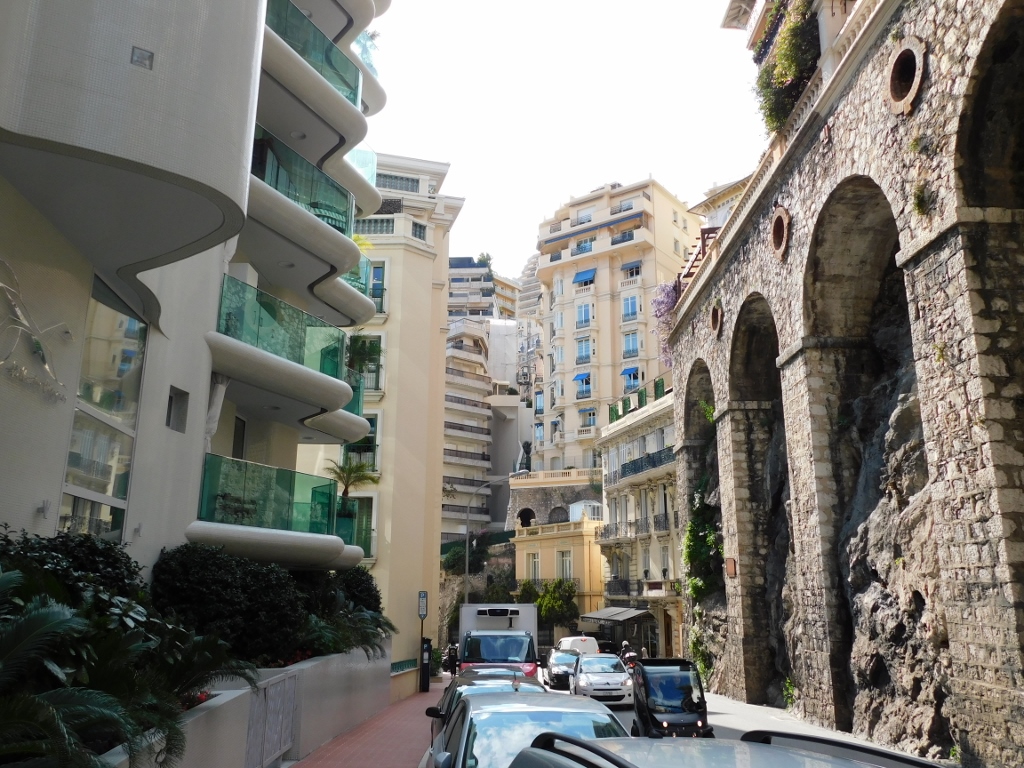 Monaco, a detail
Monaco, a detail
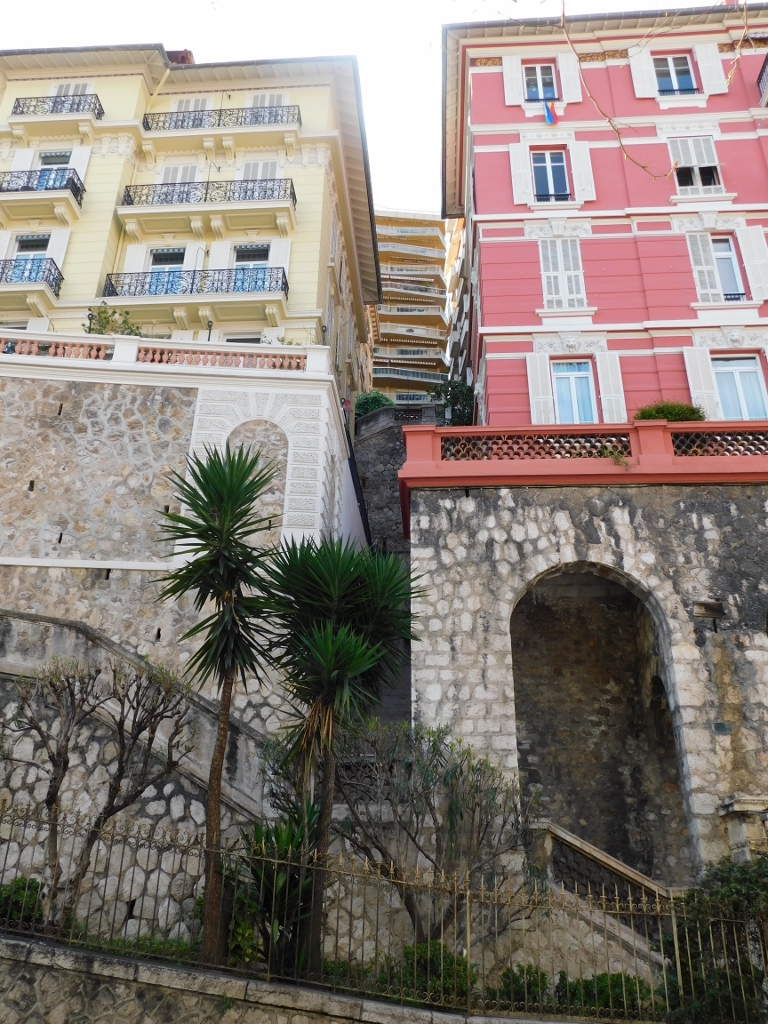 Monaco, a detail
Monaco, a detail
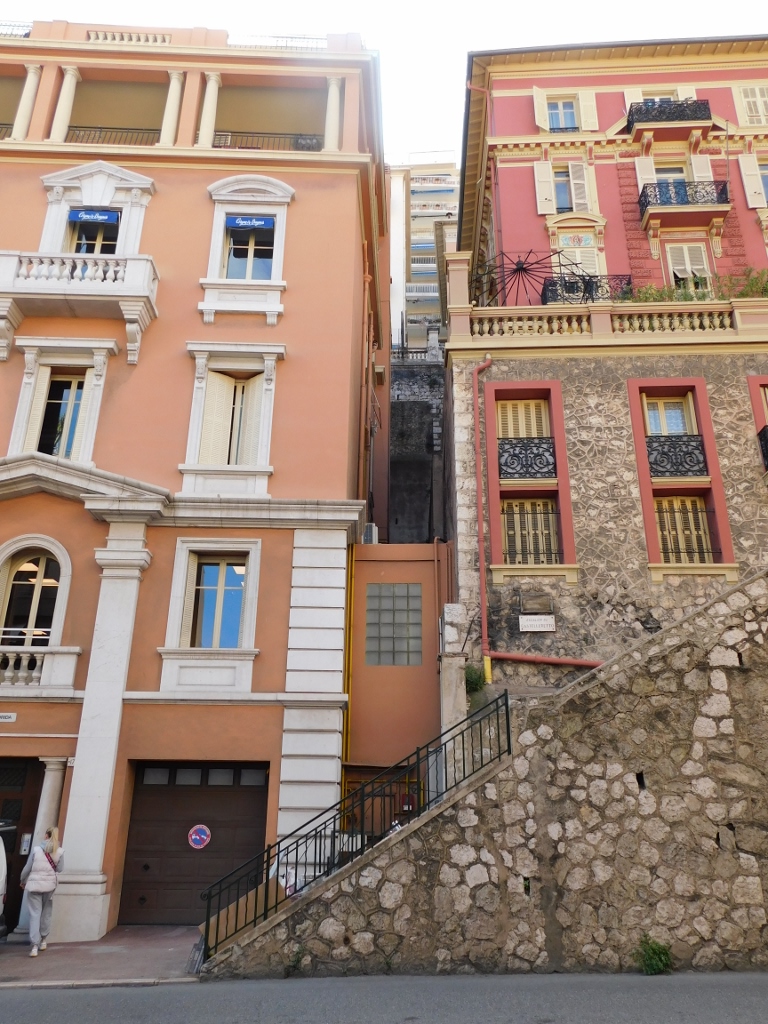 Monaco, a detail
Monaco, a detail
There are buildings here that were constructed in the 19th and the 20th centuries, but there are also some very contemporary buildings.
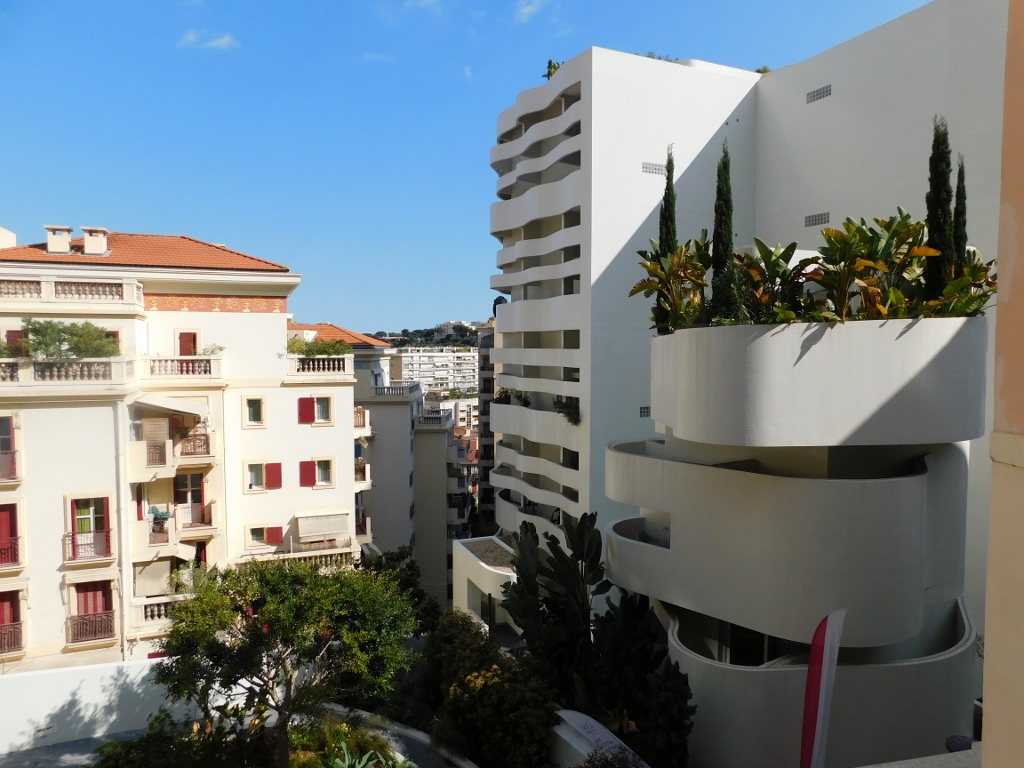 Monaco, a detail
Monaco, a detail
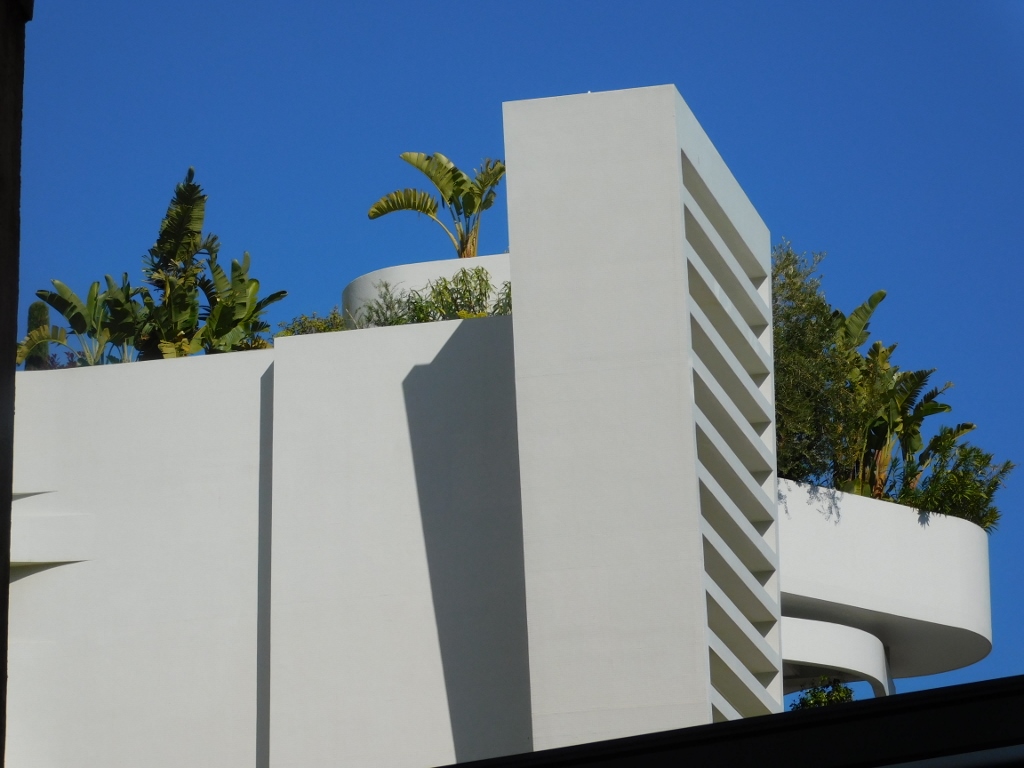 Monaco, a detail
Monaco, a detail
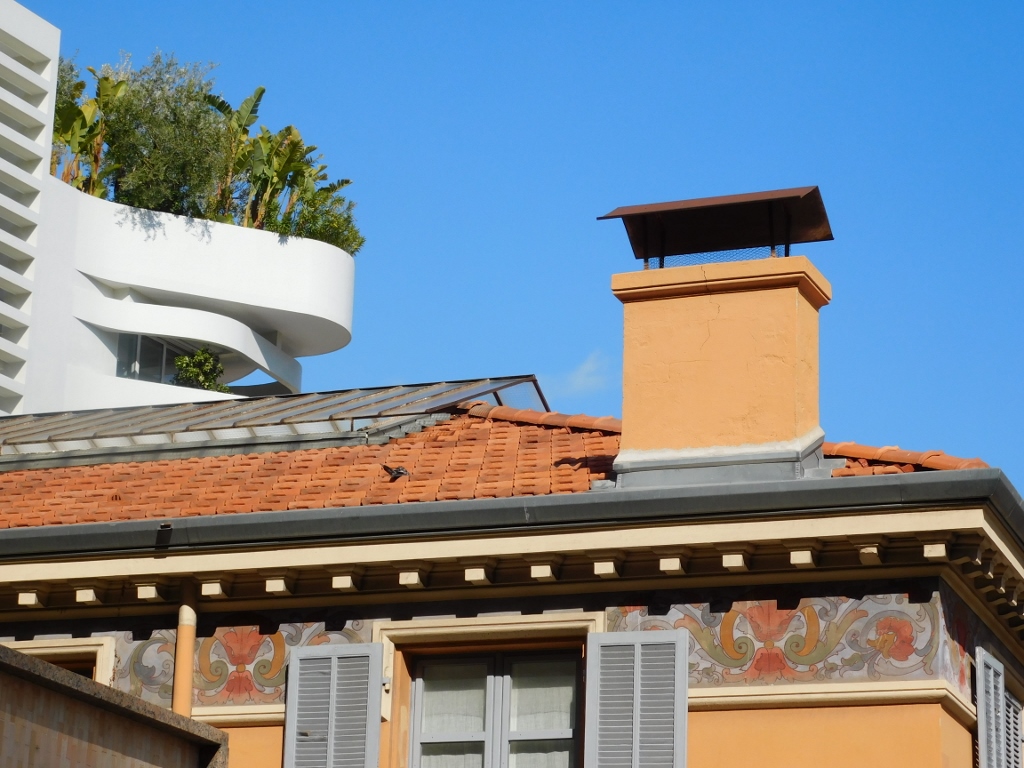 The new and the old, one next to the other
The new and the old, one next to the other
And then I reached the Place d’Armes roundabout from where I looked again at the parts of Monaco that I had just more or less walked through.
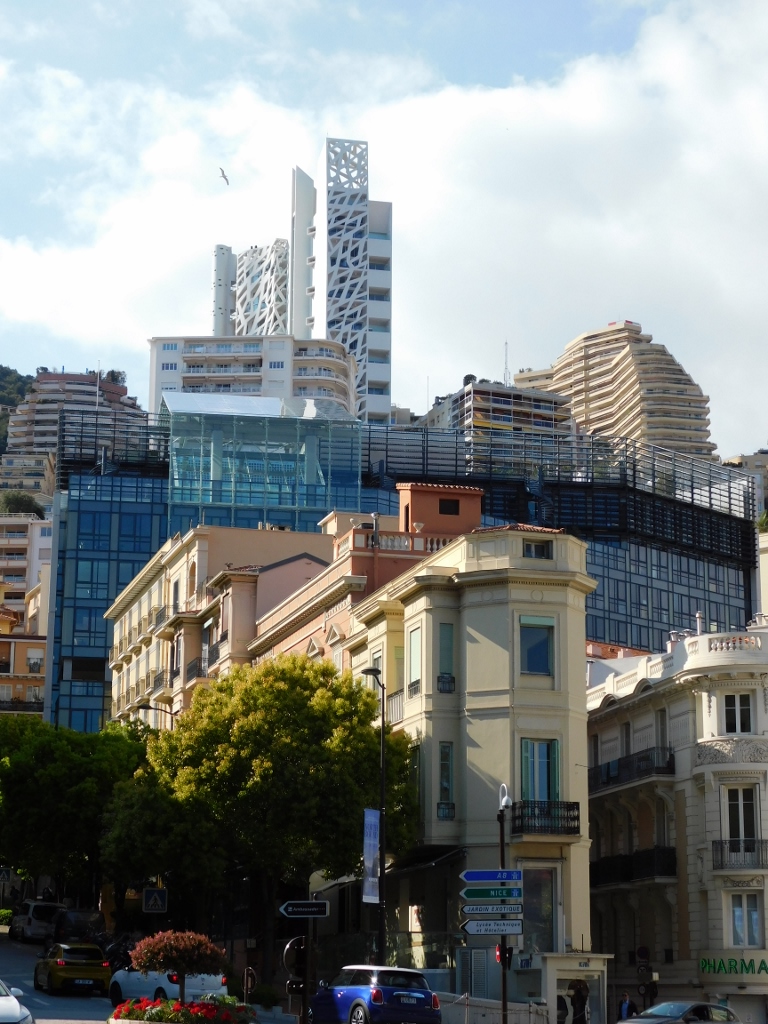 Monaco, a detail
Monaco, a detail
The roundabout has gotten its name after a nearby square of the same name – Place d’Armes and they are located in the central administrative section of Monaco, La Condamine.
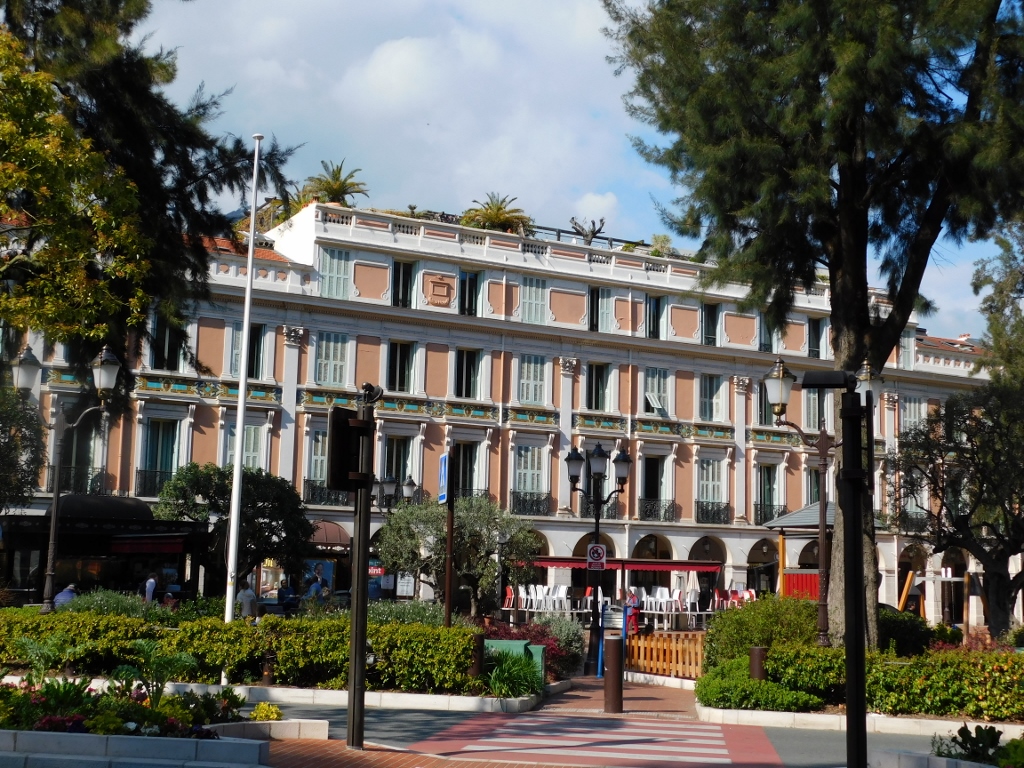 Place d’Armes
Place d’Armes
At the square there is also a market, Marché de la Condamine. At the time I was here, no stands with fruits, vegetables and flowers could be seen any longer, since the open market closes at 3 pm. But, there is also a covered segment that mainly houses food shops, as well as smaller restaurants where one can eat.
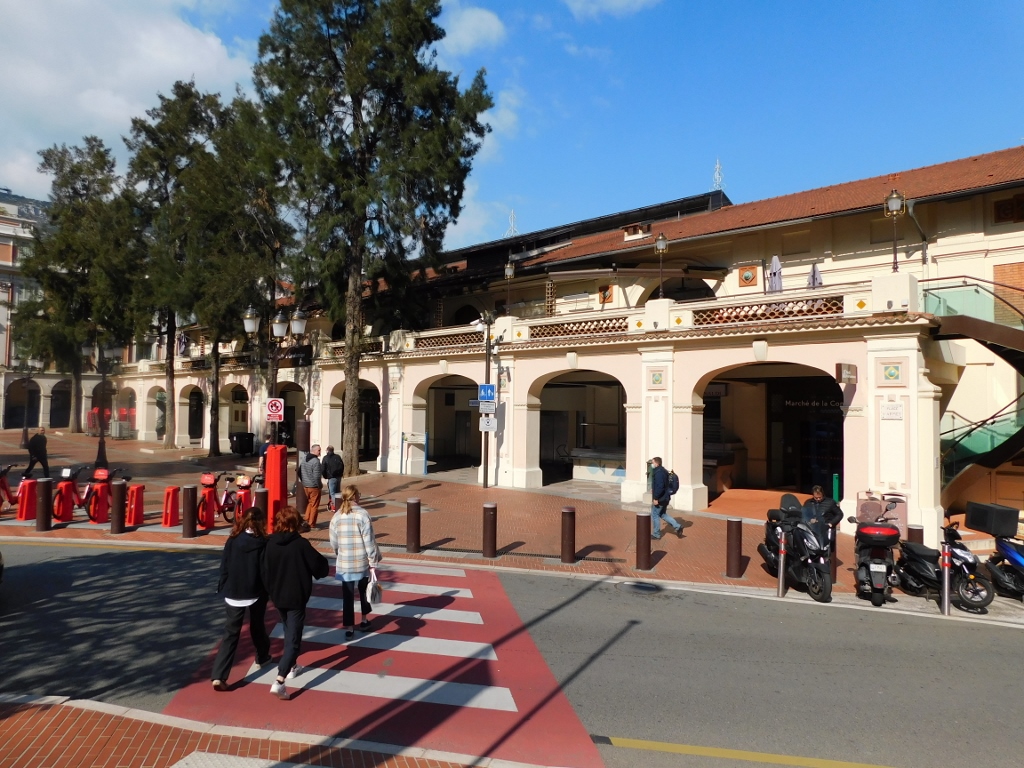 Place d’Armes, the closed segment of the Marché de la Condamine
Place d’Armes, the closed segment of the Marché de la Condamine
I did not go in there, but rather headed in the other direction which entailed climbing uphill along a wide path.
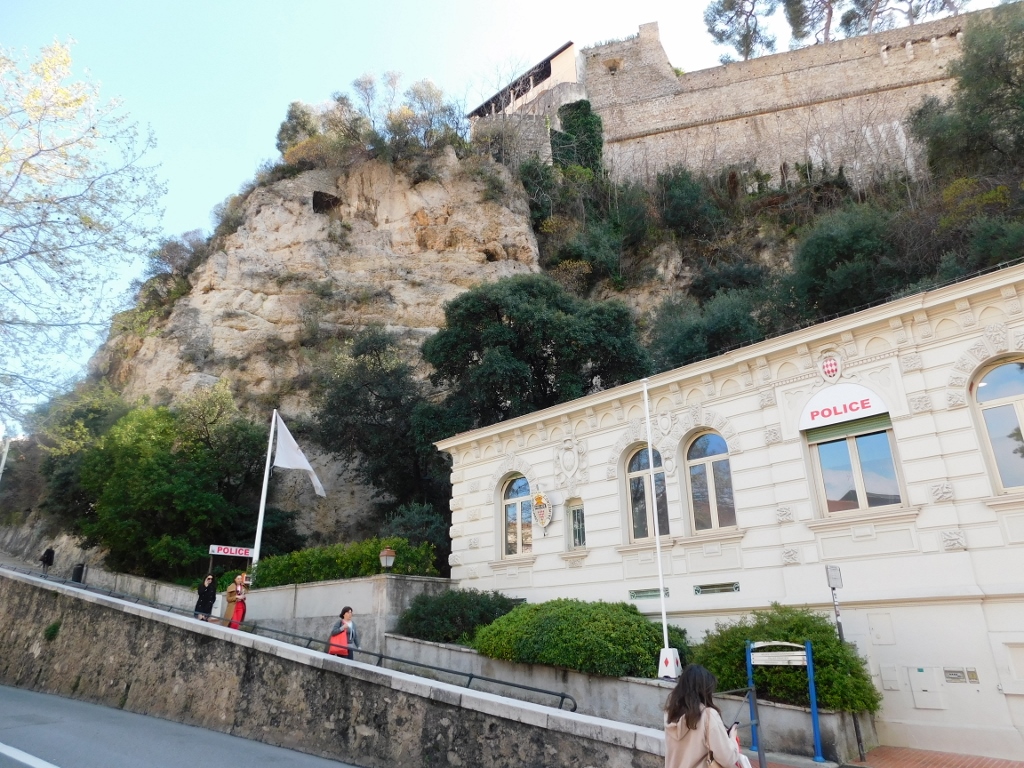 Monaco, a detail
Monaco, a detail